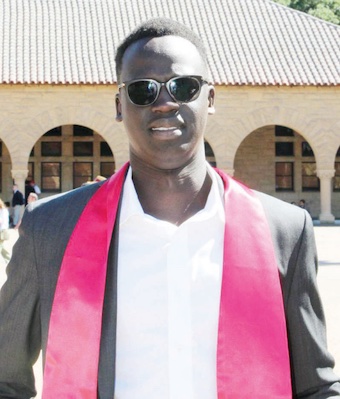
Screenshot
JOHN ATEM AGWER’s family fled conflict in South Sudan and settled in Uganda as refugees.

He would later be admitted to the elite Stanford University in the United States. While in the United States, he has set up a tech company that he hopes will inspire young people who emerge from a similar background like his, writes Derrick Kiyonga.
When John Atem Agwer’s parents gave birth to him in the border town of Nimule in 1999, the last thing they had on their mind was that their boy would make it to Stanford University in California, where he would come up with a startup that specialises in information technology.
It was very hard for them to envisage this scenario because Atem was born amid the second Sudanese Civil War, which lasted from 1983 to 2005 between the central Sudanese government and the Sudan People’s Liberation Army (SPLA), led by John Garang, who would pass in 2005 after the Ugandan presidential helicopter he was travelling in crashed along the South Sudan-Uganda border.
The second civil war in South Sudan was largely a continuation of the first Sudanese Civil War, which started in South Sudan but spread to the Nuba Mountains and the Blue Nile, lasting for over 22 years, ultimately resulting in the independence of South Sudan 6 years after the war had ended.
It’s within this context of violence that Uganda has been a home of refugees trickling from South Sudan, with official figures showing that in the 1960s, an estimated 86,000 Sudanese fled into Uganda. Between 1993 and 1994, a second major influx of an estimated 100,000 South Sudanese refugees fled into the West Nile region.
By 1995, an estimated 170,000 to 210,000 Sudanese refugees were settled in Uganda, and by the end of 2020, there were an estimated 1.4 million refugees in the country. Among South Sudanese, the refugees who settled in Uganda were Atem, who started going to Kampala metropolitan schools.
In 2012, he sat his Primary Leaving Examinations (PLE) at Kings Way Primary School, where he obtained 6 aggregates from the standard 4 subjects.
Yet in his education journey in Uganda, it’s his performance in the Uganda Certificate of Education (UCE) examinations at St Mary’s SS, Kitende (SMASK), that stood out, as he obtained 8 aggregates out of 8 subjects, qualifying him among the best performers in the country.
Yet within this moment of victory, reality set in that he could actually miss out on Atem not being able to advance to the next level, that’s the A-level, due to a lack of school fees.
The reason behind his lack of school fees again was attributed to the politics of South Sudan, where, having obtained independence, the newly born state would be plunged into a civil war.
Tensions erupted into civil war in December 2013 following a political struggle between President Salva Kiir and Vice President Riek Machar. President Kiir accused Vice President Machar of plotting a coup d’état against him, leading to Machar’s removal as vice president.
Soon after, violence erupted between presidential guard soldiers from the two largest ethnic groups in South Sudan. Soldiers from the Dinka ethnic group aligned with Kiir, and those from the Nuer ethnic group supported Machar.
Violence quickly spread to the states of Jonglei, Upper Nile, and Unity. From the outbreak of conflict, armed groups targeted civilians along ethnic lines, committed rape and sexual violence, destroyed property, looted villages, and recruited children into their ranks.
This violence affected Atem in the sense that his father, Jacob Aguer Atem, was a serving military officer in the SPLA assigned to ensure peace in Wau, Bahr al Ghazal.
The violence that the South Sudan economy has been hit with, if not collapsed, means the salary Atem’s father was getting wasn’t enough to cater for the family’s basic needs like food and shelter and also send him back to complete his high school.
Yet even when he was at dire straits, there was light at the end of the tunnel: the sense that he had carved out a niche in information technology as a self-trained software developer.
His mother, Elizabeth Achol Makuach, tells of Atem’s love for technology, saying as a teenager, his son would grab any gadget around and begin working on it. She had to hide her mobile phone at times because her son ought to allocate some good time for books.
Atem investigates all electronic and electrical appliances in the house. Atem, the mother, said she would question everything that is man-made, and this relieved the family of petty repairs on the household.
During his O-level, Atem formed WhatsApp from baptised ‘FAST’ (Finalist Alliance of ‘Scientists’), meant to facilitate discussions for science subjects such as physics discussions and practicals.
He would build to start thinking of software development therein, adopting 5 software design languages, and he started teaching about 20 members, most of them students. Still, during his O-level days, he attempted to build what he called an ‘ultralight plane’, some sort of a drone.
His mother recalled that the small indoor ‘helicopter’ almost flew. Its rotors could propel, and the lighting worked, but the idea died down due to a lack of design materials. His idea of the ‘Frog chopper’ was inspired by an online challenge from some company and the fact that he wanted to win the hearts and souls of some people to support his secondary education through the university.
Luckily, he was able to obtain school fees, completed his A-level, and applied – he dared to apply to a couple of colleges in the United States.
“I applied to a couple of schools in the United States before I was admitted to Stanford, in California. I did my undergraduate, then my master’s, and then I started my startupin IT, and then I started my company that I’m building,” Atem says.
Unlike Uganda, where there are concerted efforts by the state to support talented young people in information technology, California is famous for startups due to a combination of factors, including its historical role in technological innovation, strong access to venture capital, a culture of risk-taking, and supportive legal and academic environments.
These elements have created a dense ecosystem, particularly in Silicon Valley, where leading universities, a large pool of talented professionals, and a history of successful companies foster new ventures.
Indeed, Atem admits that the reason why he was excited about joining Stanford was this long tradition of supporting startups.
“I have always had interest in applications. The year before joining Stanford I was a firming engineer. So, when I got to Stanford, I was excited because there is no other place in the world where you easily start start-ups,” he says.
He explains how he started his company.
“I was involved in starting start-ups in Uganda, but it was difficult to get funding. One of the advantages of going to Stanford is getting access to all these opportunities and raising venture capital funding. In general, in the US, the opportunity of setting up a company is higher and easier as well,” he says.
Going forward, Atem says he still harbours the same ambition that he had when he was still a teenager. “From the time I was 15 or 16, I always wanted to have a big tech company. I’m lucky to have graduated at the turn of new technology.
In the world of start-ups, these are the best times to build something new. I could have gone on and got a job at one of those big technology companies, but I thought it was time to start something of my own,” he says.
dkiyonga@gmail.com



